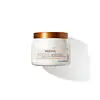What's inside
What's inside
 Key Ingredients
Key Ingredients

No key ingredients
 Benefits
Benefits

 Concerns
Concerns

 Ingredients Side-by-side
Ingredients Side-by-side

Water
Skin ConditioningCetyl Alcohol
EmollientStearyl Alcohol
EmollientCeteth-2
EmulsifyingHedychium Coronarium Flower/Leaf/Stem Extract
Skin ConditioningAlgae Extract
EmollientSimmondsia Chinensis Leaf Extract
HumectantAnthemis Nobilis Flower Extract
MaskingRosmarinus Officinalis Leaf Extract
AntimicrobialAloe Barbadensis Leaf Extract
EmollientCetrimonium Chloride
AntimicrobialGlycerin
HumectantPolyquaternium-37
Soyamidopropyl Ethyldimonium Ethosulfate
Propylene Glycol Dicaprylate/Dicaprate
EmollientPPG-1 Trideceth-6
Skin ConditioningButylene Glycol
HumectantPropylene Glycol
HumectantBisamino PEG/PPG-41/3 Aminoethyl Pg-Propyl Dimethicone
Glycine Soja Oil
EmollientSoyamidopropyl Dimethylamine
EmulsifyingDMDM Hydantoin
PreservativeIodopropynyl Butylcarbamate
PreservativeCitric Acid
BufferingCI 42090
Cosmetic ColorantPEG-12 Dimethicone
Skin ConditioningParfum
MaskingCitronellol
PerfumingCoumarin
PerfumingGeraniol
PerfumingLimonene
PerfumingHexyl Cinnamal
PerfumingWater, Cetyl Alcohol, Stearyl Alcohol, Ceteth-2, Hedychium Coronarium Flower/Leaf/Stem Extract, Algae Extract, Simmondsia Chinensis Leaf Extract, Anthemis Nobilis Flower Extract, Rosmarinus Officinalis Leaf Extract, Aloe Barbadensis Leaf Extract, Cetrimonium Chloride, Glycerin, Polyquaternium-37, Soyamidopropyl Ethyldimonium Ethosulfate, Propylene Glycol Dicaprylate/Dicaprate, PPG-1 Trideceth-6, Butylene Glycol, Propylene Glycol, Bisamino PEG/PPG-41/3 Aminoethyl Pg-Propyl Dimethicone, Glycine Soja Oil, Soyamidopropyl Dimethylamine, DMDM Hydantoin, Iodopropynyl Butylcarbamate, Citric Acid, CI 42090, PEG-12 Dimethicone, Parfum, Citronellol, Coumarin, Geraniol, Limonene, Hexyl Cinnamal
Water
Skin ConditioningCetearyl Alcohol
EmollientAmodimethicone
Behentrimonium Chloride
PreservativeCetyl Esters
EmollientIsopropyl Alcohol
SolventParfum
MaskingTrideceth-6
EmulsifyingPhenoxyethanol
PreservativeMel
EmollientArgania Spinosa Kernel Oil
EmollientTheobroma Grandiflorum Seed Butter
Skin ConditioningCetrimonium Chloride
AntimicrobialChlorhexidine Dihydrochloride
AntimicrobialLinalool
PerfumingTocopherol
AntioxidantIngredients Explained
These ingredients are found in both products.
Ingredients higher up in an ingredient list are typically present in a larger amount.
This ingredient is a preservative, antimicrobial, and emulsifier. It is often used in cosmetics for its ability to cleanse, condition, and reduce static.
Cetrimonium chloride is a quaternary ammonium salt, meaning it has a water-soluble structure.
Parfum is a catch-all term for an ingredient or more that is used to give a scent to products.
Also called "fragrance", this ingredient can be a blend of hundreds of chemicals or plant oils. This means every product with "fragrance" or "parfum" in the ingredients list is a different mixture.
For instance, Habanolide is a proprietary trade name for a specific aroma chemical. When used as a fragrance ingredient in cosmetics, most aroma chemicals fall under the broad labeling category of “FRAGRANCE” or “PARFUM” according to EU and US regulations.
The term 'parfum' or 'fragrance' is not regulated in many countries. In many cases, it is up to the brand to define this term.
For instance, many brands choose to label themselves as "fragrance-free" because they are not using synthetic fragrances. However, their products may still contain ingredients such as essential oils that are considered a fragrance by INCI standards.
One example is Calendula flower extract. Calendula is an essential oil that still imparts a scent or 'fragrance'.
Depending on the blend, the ingredients in the mixture can cause allergies and sensitivities on the skin. Some ingredients that are known EU allergens include linalool and citronellol.
Parfum can also be used to mask or cover an unpleasant scent.
The bottom line is: not all fragrances/parfum/ingredients are created equally. If you are worried about fragrances, we recommend taking a closer look at an ingredient. And of course, we always recommend speaking with a professional.
Learn more about ParfumWater. It's the most common cosmetic ingredient of all. You'll usually see it at the top of ingredient lists, meaning that it makes up the largest part of the product.
So why is it so popular? Water most often acts as a solvent - this means that it helps dissolve other ingredients into the formulation.
You'll also recognize water as that liquid we all need to stay alive. If you see this, drink a glass of water. Stay hydrated!
Learn more about Water